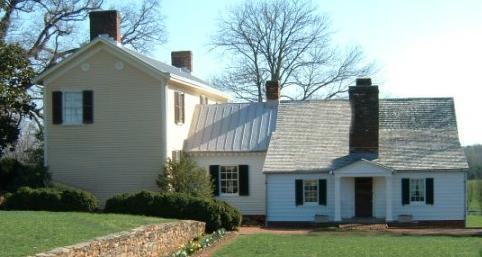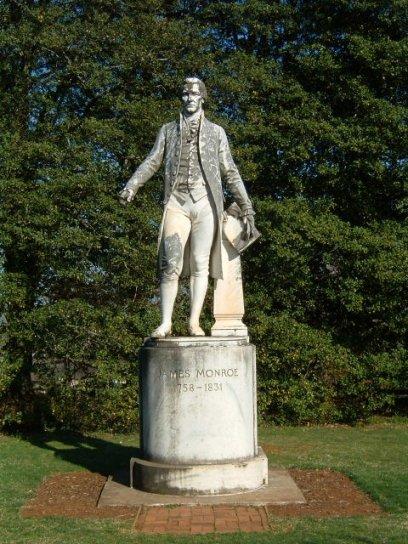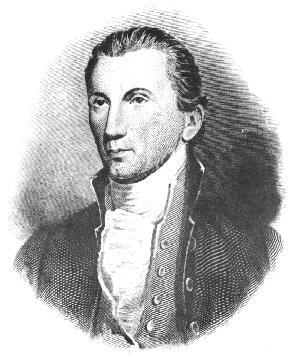Monroe served
well and was a courageous officer and was severely wounded at the
Battle of Trenton, just before Washington's famous crossing of the
Delaware, as well as spent the winter with him at Valley Forge.
Following six years of fighting, the war ended and America won its
freedom from England and a new nation was formed, the United States
of America.
To help build
this new nation, James would spend much of his life serving his
country. In 1803 to 1807 he was a U.S. Minister in France,
England and Spain. While in France, it was Monroe that assisted in
an agreement that would permit the United States to buy all the land
between the Mississippi River and the Rocky Mountains, known as the
Louisiana Purchase, which by doing so, the United States more than
doubled in size. In later years, Monroe also would serve as James
Madison's
Secretary of State and War during the War of 1812.
It was Monroe's
vision that caused him to look at the United States as a total
nation, rather than a group of different geographical areas. Besides
the Louisiana Purchase, one of his most famous actions was his
Monroe Doctrine. In this, Monroe said that all countries in
North and South America should be free from European control and
dominance. This came as a result because during his presidency, many
of his cabinet members and advisors came from different countries.
Although
tirelessly dedicated to serving the United States, his first love
was that of his native Virginia. As a young man he served in
Richmond as a member of the Virginia General Assembly where he
helped make new laws for the state. In later years he would go on to
serve of its governor four times, as well as he represented Virginia
in the United States Senate. When his good friend Thomas Jefferson
had founded the University of Virginia, Monroe helped govern the new
institution, and once owned the land, which is the main ground of
the university today. Upon retiring from the presidency, James also
helped write Virginia's
new constitution.
James Monroe and
his wife Elizabeth and their daughters, Eliza and Maria Hester,
lived next to Jefferson's
Monticello in Charlottesville, in a plantation house known as
Highland in 1799, which is Ash Lawn-Highland today, at 1000 James
Monroe Parkway. Besides being good friends with Jefferson, they also
were close to James and Dolley Madison, and is it said that they
were the Monroe's
first guests they entertained upon moving there. It is said that
Monroe's friend Thomas Jefferson, who lived only two and a half
miles away at Monticello, selected the house's location and helped
design it. In fact, an early letter written by Jefferson while in
Europe to Monroe exists, in which Jefferson asks Monroe, "What
measures have you taken for establishing yourself near Monticello?"
Monroe's "cabin
castle"
as he called it, was once part of a 1,000-acre plantation.

When the Monroe's
lived at Highland, 30 to 40 slaves and freed servants worked to
serve the Monroe family and their guests. The field slaves had
quarters at some distance from the main house, but the house
servants lived close to the big house in a three-bay / three-family
slave quarter. The slave dwellings had fireplaces for cooking and
warmth. The present slave quarter building has been reconstructed.

Ash Lawn-Highland
is an historic house museum, a 535-acre working farm, and performing
arts site. It was here that the Monroe family lived until their
house at Oak Hill was built. Monroe and his wife, Elizabeth
Kortright Monroe of New York, owned the property from 1793 to 1826
and made it their official residence from 1799 to 1823. After the
Monroe's' death, the name of their farm was changed from "Highland"
to "Ash Lawn,
and today both names are used.
Philanthropists
Jay Winston and Helen Lambert Johns opened ash Lawn-Highland to the
public in 1931. Upon Mr. John's death in late 1974, Mr. Johns
bequeathed Ash Lawn-Highland to the College of William and Mary,
both his and James Monroe's alma mater. Accepting the Johns bequest
"to operate this property as a historic shrine for the education of
the general public," the College initiated new programs in
restoration and interpretation at Ash Lawn-Highland.
Ash Lawn-Highland
continues the tradition begun by the Monroe=s
of welcoming friends, neighbors, dignitaries, and visitors. James
Monroe's "place of comfort and hospitality" is the scene of
meetings, parties, picnics, a summer music festival, and a variety
of educational and special events. It continues to provide an
authentic view of nineteenth-century life for our many other
visitors through examples of early American and Victorian
architecture, decorative arts from those periods, and craft
demonstrations on the grounds.
When visiting Ash
Lawn-Highland, upon entering the mansion house, you find yourself in
the entrance hall. Exhibits here and in the adjoining exhibit room,
are both part of the wing that was added in the 1880s, which
introduce James Monroe, his family, and his political career. The
drop-leaf table, circa 1825, is made from Honduras mahogany. It was
sent to Monroe on behalf of the people of Santo Domingo, now the
Dominican Republic, in gratitude for Monroe's statement of foreign
policy, known as the Monroe Doctrine. A framed copy of quotations
from the Monroe Doctrine hangs in this room. In addition to a bust
of Monroe, sculpted by Attilio Piccirilli in 1931, the room features
a selection of china used by the Monroe's
in the White House and their residences.

Although Monroe's
"cabin-castle" is typical of farmhouses in the 1800s, the
furnishings are distinctive and elegant. It provides visitors with
the opportunity to see a variety of furnishings and decorative items
from the eighteenth and nineteenth centuries.
The Monroe=s
imported many items from Napoleon's France. For example, the chairs
in the drawing room are fine examples of the Neoclassical influence
during the French Empire that were crafted in Paris about 1800. The
Chaudet bust of Napoleon is something that he himself gave to
Monroe. The antique nineteenth-century wallpaper, Paysage a
Chasse by Jean Zuber, re-creates the feeling of tapestries
owned by the Monroe=s,
and the carpet features French Empire decorative details. Queen
Hortense of Holland gave the three portraits (of herself, her
brother Eugene, and Madame Campan, headmistress of the school
attended by Hortense and Eliza Monroe) to the Monroe=s
upon the christening of Hortensia Monroe Hay, Eliza's daughter and
the first Monroe grandchild. In addition to the classically inspired
French furnishings imported from Europe at the time of Napoleon,
visitors find American craftsmanship in Monroe's mahogany bed and
other furniture following the designs of Duncan Phyfe. Earlier
American designs such as a mid-eighteenth-century table and a
Windsor rocker are also present. Imported English styles include the
bow front china cabinet and a set of eagle-back chairs dating to the
time of George III (1738-1820) and George IV (1762-1830), who served
as Prince Regent from 1810 to 1820.
The dining room
features a Hepplewhite dining table purchased shortly after the
Monroe's marriage in 1786, and the addition of semicircular banquet
ends allows it to be expanded for guests. The table setting
showcases a circa-1815 epergne and a gleaming English plateau. The
Monroe's
used the imported French mirror, or pier glass, to enhance the sense
of space in a room and to reflect light from candles, still an
important source of illumination in the 1800s. Part of a two-dozen
set, the hand-carved chairs are an American Federal interpretation
of the French Empire style. The hand-painted floor cloth is
reminiscent of floor coverings of the period.
In the Monroe’s'
bedroom, you will find a high-post bed, distinguished by its
hand-carved feather-and-palm motifs, conceals a trundle, which
provided additional sleeping space. Eli Terry of Connecticut, the
clockmaker who taught Seth Thomas, is believed to have made the
pillar-and-scroll clock on the mantel. The American marble-topped
chest of drawers was made for Monroe and was used in the White
House. The shaving mirror found here was crafted from salvage after
the British burned the White House during the War of 1812.
James Monroe's
study, which he added in 1816, offers reminders of the fifth
president's political career. The Louis XVI desk is almost identical
to the desk upon which Monroe wrote his 1823 address to Congress,
which is known as "Monroe Doctrine." Newspapers seen on the desk
report on President Monroe's official tours. Monroe used the early
19th-century French clock on the mantle during his presidency while
in the White House. The bow front cabinet is adorned with a
miniature portrait of an unknown British gentleman. The original
desk on which Monroe wrote his "Doctrine" is today in the James
Monroe Museum in Fredericksburg, Virginia.
During the time
of Monroe, continuous activity occurred in the kitchen and the
service yard to the south of the main house. Servants would prepare
meals in the basement or "the stone kitchen cellar," described as
such by Monroe in his 1809 insurance policy. Nearby stairs offer an
easy access to the upper gallery porch from the kitchen and
adjoining wine cellar. Within a few steps away, water could be drawn
from Monroe’s well. The neatly organized kitchen yard still contains
the original Smokehouse for curing meats and fish and the Overseer's
Cottage, possibly the oldest building still standing on the farm.
Between those two buildings stands a reconstruction of the original
three-room Slave Quarters, as it was customary at the time for the
house servants to live near the main house. When the Monroe's
lived at Highland, 30 to 40 slaves and freed servants worked to
serve the Monroe family and their guests. The field slaves had
quarters at some distance from the main house, but the house
servants lived close to the big house in a three-bay-three-family
slave quarter. The slave dwellings had fireplaces for cooking and
warmth.
On the far side
of the kitchen yard, an icehouse preserved ice, which was cut from a
shallow pond and stored between layers of straw or sawdust from
Monroe's sawmill.
When Monroe added
his study in 1816, he also added the children's room. This room
contains a king's crown canopy bed like that in which Maria Hester
slept, the Monroe’s' younger daughter. At age 11, Maria Hester
Monroe stitched the sampler that sits beside the bed.
Admission to Ash
Lawn-Highland is Adults: $9.00; Seniors (60 and older): $8.00;
AAA-Members (with ID): $8.00; Children (6-11): $5.00; and Local
Residents from the counties of Albemarle, Augusta, Buckingham,
Fluvanna, Greene, Louisa, Nelson, Orange and Rockingham, $5.00.
Local residents
admission is free when bringing a full-paying out-of-town guest. Ash
Lawn - Highland is now famous for the magnificent boxwood and the
peacocks that reside there.
Following the
death of his beloved wife, Elizabeth, who died 1830, James Monroe
left Virginia for the last time to live with his younger daughter in
New York City. It would be here that he died at the age of 73 on
July 4, 1831, five years to the day after John Adams and, his old
friend Thomas Jefferson, had died. In the last months of his life,
Monroe would think often of his beloved Virginia and his friends
there. Upon his death, Monroe was first buried in New York, but in
1858, was returned home to Virginia, and now rests in Hollywood
Cemetery in Richmond.
On the grounds of
Ash Lawn-Highland is a Historic Marker that reads: This estate was
the home of James Monroe, fifth President of the United States. In
1793, James and Elizabeth Kortright Monroe purchased 1,000 acres
adjoining Jefferson's Monticello. Called Highland, the plantation,
eventually totaling 3,500 acres, was their principal residence from
1799 to 1823. Known in foreign affairs for the Monroe Doctrine,
James Monroe also served as governor of Virginia for four one-year
terms, U. S. Minister to England, France, and Spain, U. S. senator,
and secretary of state and war. Enlarged and renamed by subsequent
owners, Ash Lawn - Highland is now owned by Monroe's alma mater, the
College of William and Mary.
When you plan
your next visit to Monticello, be sure to stop and visit Ash
Lawn-Highland!

Quick
Biographical Facts:
JAMES MONROE
5th President
Term- March 4, 1817 to March 4, 1825
Democratic-Republican Party

Birth:
Westmoreland County, Virginia, April 28, 1758.
Ancestry:
Scotch
Marriage:
New York, New
York, February 15, 1786 to Elizabeth Kortright who was born in New
York City, June 30, 1768. Elizabeth died in Oak Hill, Virginia,
September 23, 1830 and is buried in Hollywood Cemetery, Richmond,
Virginia.
Children:
Eliza (1787- ?); Maria Hester (1804-1850).
Homes:
Ash Lawn-Highland, Charlottesville, Virginia; Oak Hill, Loudown
County, Virginia.
Education:
Parson Campbell's School; College of William and Mary.
Religion:
Episcopalian
Occupation before
Presidency:
Lawyer
Military Service:
Officer in Third Virginia Regiment and Continental Army (1776-1779).
Pre-Presidential
Offices:
Military Commissioner for Southern Army; Representative to Virginia
Legislature; Member of Governor Jefferson's Council; Representative
to Continental Congress, Virginia House of Delegates, Virginia
Assembly, U.S. Senate; Minister to England; Governor of Virginia;
Secretary of State and of War.
Age at
Inauguration:
58
First
Administration:
Vice-President: Daniel D. Tompkins of New York, Inauguration March
4, 1817, The Capital, Washington D.C.
Second
Administration:
Vice-President: Daniel D. Tompkins of New York, Inauguration March
5, 1821, House of Representatives, Washington D.C.
Occupation after
Presidency:
Writer
Death:
New York, New York, July 4, 1831
Cause of Death:
Debility at age 73.
Place of Burial:
Hollywood Cemetery, Richmond, Virginia.
Interesting
Facts:
His greatest
legacy as President was the Monroe Doctrine of 1823, encouraging
European nations to keep their hands off the American continent and
promising that the United States would stay out of European
quarrels. Monroe was the first President to use a globe to explain
the Monroe Doctrine to his cabinet.
The Marine Band
made its first public appearance at the second inaugural of James
Monroe.
Monroe carried a
dismal reminder of the Revolutionary War. It was a bullet, lodged in
his left shoulder, received at the Battle of Trenton. It remained
there throughout his life.
Maria Hester
Monroe, the daughter of James Monroe, was the first daughter of a
President to be married in the White House in 1820.

